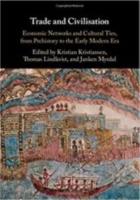
CUP (2018) h/b 553pp £110 (ISBN 9781108425411)
This book stems from three interdisclipinary conferences held in Sweden in 2011, 2012 and 2013 after which it was agreed to put together a collection of contributions on the general theme of Trade and Civilisation. There are 20 papers in the collection from 21 contributors, internationally spread but with a slight preponderance from Scandinavia and America. It is lavishly produced with a wide range of maps and diagrams. Each contribution is followed by a generous list of references. The first and the two final sections attempt generalisations, while the remaining seventeen are case studies. The first group deal with the ancient Indo-European world while the remainder range over Asian, African, Pacific, South American and more recent European episodes.
This is inevitably a book written by professional academics for other professional academics and as such is a dense read for the general reader. There is a depressing amount of jargon in some contributions: ‘Thus, the notion of comparative advantage concretises the total sum of social reproduction, i.e. the mode of production’. There is also much referencing back to earlier studies where the evidence adduced by those studies (as distinct from their conclusions) is assumed to be known to the reader. There is in addition the risk that a general principle may be advanced on the basis of exiguous evidence.
The main academic debates centre round whether trade leads to the development of civilisations (in both directions) or whether it is the presence of a civilisation which creates trading opportunities. There are also intermittent echoes of a debate between a Marxist and a capitalist theory of the development of trade.
Some solid elements emerge. Trade requires (at least at one end of the exchange) a settled society. You do not go in search of someone who will exchange what you have available unless you know where to find him and unless you are reasonably certain that you will get there and back safely. The things that he might want include staples (metals and textiles) or trophy items (jewels or the tripods kept in Nestor’s storeroom). Once you have met him you need to have developed and agreed a concept of equivalence in order to complete the exchange.
The case studies demonstrate not only that these conditions were sufficiently met very soon after the first settlements were formed but that they can be met in a wide variety of ways in different eras and in different geographies. Members ofClassics for Allmight find particular interest in Toby Wilkinson on cloth and currency in the 5thto 2ndBC and David Warbuton on prices and values and their origins and early history in the Near East. Incredibly it emerges that there was already by 3000 BC a recognised arbitrage opportunity between official and market rates of exchange. Despite being jargon heavy, Michael Galaty’s explanation of why Messenia developed in a different way from the Argolid—‘Mycenean Glocalism’—is also worth the effort.
The reviewer must end by recognising the overall prodigious level of scholarship displayed by the contributors.
Roger Barnes
